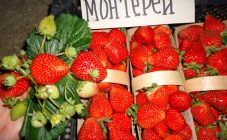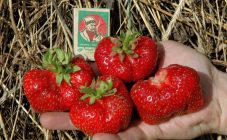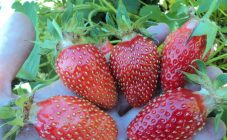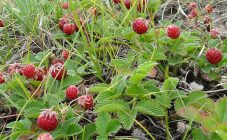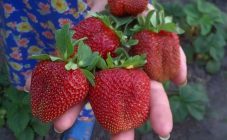Content:
One of the most popular berry crops grown in garden plots are strawberries and garden strawberries. Russian summer residents have been engaged in its cultivation for more than one decade. And if a couple of decades ago only varieties of strawberries of the Russian selection were grown on garden beds, then recently summer residents prefer to buy seedlings of this berry crop of imported varieties - from Italy, Spain or the Netherlands.
Imported varieties turned out to be high-yielding, and ripe berries were tasty, therefore they became popular among domestic gardeners. However, gardeners often buy low-quality fakes, which do not have all the positive qualities of the originals, instead of original well-known foreign varieties. Also, some varieties from the southern regions of the European continent and America are not zoned for most areas of our country. As a result, they do not take root well in Russian beds, the expected yield decreases, but most often the bushes simply freeze out.
According to Russian gardeners, it is much better to buy Japanese varieties of strawberries - the climate in Japan is much closer to most Russian regions, so this imported strawberry will feel good in the gardens of our country. The main distinguishing characteristics of Japanese strawberry varieties: large fruit sizes and their excellent taste.
One of the best Japanese varieties is Tsunaki strawberry (erroneously named Tsunami strawberry). Although in Russia, this Japanese strawberry is not yet very common, since the seedlings of this variety appeared in the vastness of our homeland only a few years ago. But some gardeners believe that the Japanese Tsunaki strawberries are a fake of Japanese varieties (like Chamora Turusi, Kipcha and some other varieties of strawberries, presumably Japanese).
General information about culture
Although this variety exists, and the seedlings are indeed discharged from Japan, but where and by whom it was created is unknown, since there is simply no mention of Tsunaki strawberries on Japanese sites, but there is a lot of information about other Japanese species of such berry culture. Despite this, it is Tsunaki who is the strawberry with the largest and most delicious berries, which has no equal in the world, this is known not only to the Japanese, but also to gardeners from other countries.
This garden strawberry can be confidently called the queen among other varietal strawberry varieties for the amazing dessert taste of berries, practically free of water, sweet and tender. And although Tsunaki appeared in our country later than other Japanese varieties of strawberries, many gardeners who planted it in their garden have already appreciated all the positive qualities of these strawberry bushes.
Strawberry (strawberry) Tsunaki: variety description
This strawberry has a high growth force - in the spring it begins to actively build up its vegetative mass, as a result, the height of the bushes can reach 60-80 cm, and the diameter - up to 0.7 m. None of the strawberry varieties have such sizes.
These giants require more space in the beds than ordinary varieties, but their peduncles and whiskers are “pencil” sized (up to 1 cm in thickness). The foliage of this strawberry matches the size of the bushes - large, bright emerald in color, and the shape is typically strawberry.
The root system of Tsunaki is powerful and strong, thanks to this structure of the roots, the bushes calmly tolerate a temporary lack of moisture, and also develop frost resistance. Gardeners who have grown this variety not for the first season, note that Tsunaki bushes can not be covered for the winter not only in the Volga region, but also in the middle lane, in the Urals, in the regions of the Far East.
In terms of ripening, Tsunaki belongs to the mid-season. You can harvest ripe berries from these bushes by mid-July. Even if the berries are not yet ripe, their taste is already like ripe ones - sweet, not watery, dessert. In short, it is a giant black strawberry flavor.
The yield characteristic is as follows: up to 1.9 kg of ripe fruits are harvested from each bush. This variety belongs to short-day varieties, the crop is harvested only once a season. But Tsunaki's yield increases significantly when grown indoors. In greenhouse conditions, if gardeners take care of it intensively, the yield increases to 2.5-3 kg.
The size of the fruits can reach 130 g, and in diameter - up to 8 cm.But after 5-6 seasons, the fruits become smaller, and their weight can be no more than 7.5 g. The shape of the berries cannot be called correct - it can be bumpy, with a characteristic scallop at the top of the fruit.
This berry plant does not belong to early ripening, therefore, it grows as much as possible several seasons after planting in open ground. In the first season after planting, the yield will be low, but do not be upset - this is quite natural.
You can grow this strawberry in one place for 6 seasons and then change the plot for this strawberry plantation. Young bushes within 2-3 seasons give a lot of whiskers, with the help of which this culture is propagated. True, the rooting time of antennae is much longer than that of other strawberry varieties, but the number of Tsunaki strawberry seedlings will be much larger.
Agrotechnics
The agricultural technology of this variety does not differ from the care of other varieties of strawberries: a sunny area with fertile soil is also required. But the distance between the planting holes should be 20-30 cm more than for ordinary strawberry bushes.
After planting, the main care consists in regular watering, loosening row spacings, removing weeds and applying top dressing.
Advantages and disadvantages of the variety
The main advantages of the variety include:
- large size of bushes;
- the giant size of ripe berries;
- excellent taste of the collected fruits;
- high productivity.
There are practically no flaws in the variety. But it should be noted that it is still quite difficult to find seedlings of this variety, since Tsunaki strawberries are not yet very common in our country. It should also be noted that the ripe fruit does not look very beautiful.



